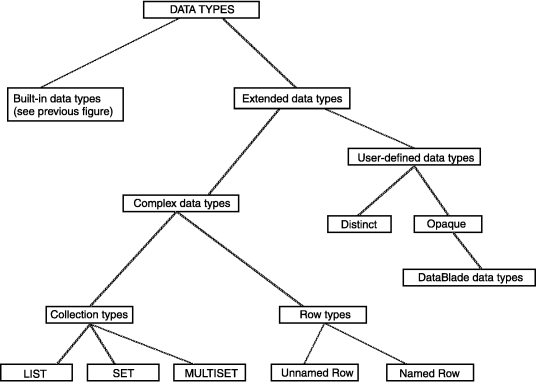
Extended data types let you create data types to characterize data that cannot be easily represented with the built-in data types. However, you cannot use extended data types in distributed transactions. Figure 26 shows the extended data types.

Complex data types describe either a collection of data objects, all of one type (LIST, SET, and MULTISET), or groups of objects of different types (named and unnamed rows.)
An extended data type is a data type that is not provided by the database server. You must provide all of the information that the database server needs to manage opaque data types or distinct data types.
A distinct data type is an encapsulated data type that you create with the CREATE DISTINCT TYPE statement. A distinct data type has the same representation as, but is distinct from, the data type on which it is based. You can create a distinct data type from built-in types, opaque types, named row types, or other distinct types. You cannot create a distinct data type from any of the following data types:
When you create a distinct data type, you implicitly define the structure of the data type because a distinct data type inherits the structure of its source data type. You can also define functions, operators, and aggregates that operate on the distinct data type.
For information about distinct data types, see Casting Distinct Data Types, the IBM Informix: Guide to SQL Syntax, and the IBM Informix: Guide to SQL Reference.
An opaque data type is an encapsulated data type that you create with the CREATE OPAQUE TYPE statement. When you create an opaque data type, you must explicitly define the structure of the data type as well as the functions, operators, and aggregates that operate on the opaque data type. You can use an opaque data type to define columns and program variables in the same way that you use built-in types.
For information about creating opaque data types, see IBM Informix: User-Defined Routines and Data Types Developer's Guide and the IBM Informix: Guide to SQL Syntax.
The diagram in Figure 26 includes DataBlade data types although they are not actually data types. A DataBlade is a suite of user-defined data types and user-defined routines that provides tools for a specialized application. For example, different DataBlades provide tools for managing images, time-series, and astronomical observations. Such applications often require opaque data types as well as other user-defined data types. For information about developing a DataBlade, refer to the IBM Informix: DataBlade API Programmer's Guide and the DataBlade Developers Kit. For information about the DataBlades that IBM provides, contact your customer representative.
Home | [ Top of Page | Previous Page | Next Page | Contents | Index ]